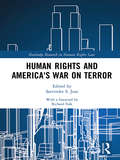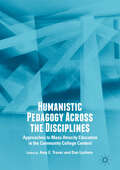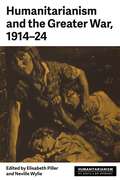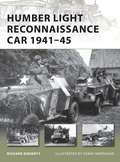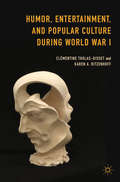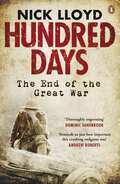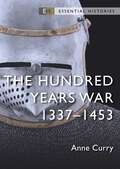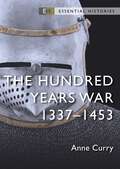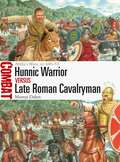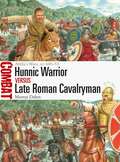- Table View
- List View
Human Resource Management in the British Armed Forces: Investing in the Future
by Alex Alexandrou Richard Bartle Richard HolmesThis study of the future of human resource management in the British armed forces considers the impace of the Human Rights Act 1998 and the Macpherson report. It covers ethnic minorities and gay rights as well as other challenging human resource issues.
Human Rights and America's War on Terror (Routledge Research in Human Rights Law)
by S. Juss SatvinderThis volume examines the success of the 9/11 attacks in undermining the cherished principles of Western democracy, free speech and tolerance, which were central to US values. It is argued that this has led to the USA fighting disastrous wars in Afghanistan and Iraq, and to sanctioning the use of torture and imprisonment without trial in Guantánamo Bay, extraordinary rendition, surveillance and drone attacks. At home, it has resulted in restrictions of civil liberties and the growth of an ill-affordable military and security apparatus. In this collection the authors note the irony that the shocking destruction of the World Trade Center on 9/11 should become the justification for the relentless expansion of security agencies. Yet, this is a salutary illustration of how the security agencies in the USA have adopted faulty preconceptions, which have become too embedded within the institution to be abandoned without loss of credibility and prestige. The book presents a timely assessment of both the human rights costs of the ‘war on terror’ and the methods used to wage and relentlessly continue that war. It will be of interest to researchers, academics, practitioners and students in the fields of human rights law, criminal justice, criminology, politics and international studies.
Human Rights and America's War on Terror (Routledge Research in Human Rights Law)
by Satvinder S. JussThis volume examines the success of the 9/11 attacks in undermining the cherished principles of Western democracy, free speech and tolerance, which were central to US values. It is argued that this has led to the USA fighting disastrous wars in Afghanistan and Iraq, and to sanctioning the use of torture and imprisonment without trial in Guantánamo Bay, extraordinary rendition, surveillance and drone attacks. At home, it has resulted in restrictions of civil liberties and the growth of an ill-affordable military and security apparatus. In this collection the authors note the irony that the shocking destruction of the World Trade Center on 9/11 should become the justification for the relentless expansion of security agencies. Yet, this is a salutary illustration of how the security agencies in the USA have adopted faulty preconceptions, which have become too embedded within the institution to be abandoned without loss of credibility and prestige. The book presents a timely assessment of both the human rights costs of the ‘war on terror’ and the methods used to wage and relentlessly continue that war. It will be of interest to researchers, academics, practitioners and students in the fields of human rights law, criminal justice, criminology, politics and international studies.
Human Rights and Counter-terrorism in America's Asia Policy (Adelphi series)
by Rosemary FootThis book examines the effects of the terrorist attacks on New York and Washington of 11 September 2001 on America's human rights and counter-terrorism policies towards a number of countries in Asia. Five countries have been chosen for examination, divided into two front-lines states (Pakistan and Uzbekistan), two second-front countries (Indonesia and Malaysia), and a third-front country, China. The paper also looks at changes in US domestic legislation and its treatment of prisoners at Guantanamo Bay and elsewhere in order to analyse the extent to which the US promotion of an external human rights policy might also have been compromised by its own legislative changes as a result of the struggle against terrorism. The paper concludes that the attacks on US territory, overall, have constrained America's willingness and capacity to promote an external human rights policy with respect to these five countries. However, some attention - especially at the rhetorical level - to these countries' human rights records has been retained to differing degrees among the five states. This degree of difference is not explained entirely in reference to a country's perceived centrality to the struggle against terrorism. It depends on the extent to which the US executive and legislative branches are united - either singly or in combination - in their disapproval of a state's record, or in their understanding about how best to reach the policy goals that are sought.
Human Rights and Counter-terrorism in America's Asia Policy (Adelphi series)
by Rosemary FootThis book examines the effects of the terrorist attacks on New York and Washington of 11 September 2001 on America's human rights and counter-terrorism policies towards a number of countries in Asia. Five countries have been chosen for examination, divided into two front-lines states (Pakistan and Uzbekistan), two second-front countries (Indonesia and Malaysia), and a third-front country, China. The paper also looks at changes in US domestic legislation and its treatment of prisoners at Guantanamo Bay and elsewhere in order to analyse the extent to which the US promotion of an external human rights policy might also have been compromised by its own legislative changes as a result of the struggle against terrorism. The paper concludes that the attacks on US territory, overall, have constrained America's willingness and capacity to promote an external human rights policy with respect to these five countries. However, some attention - especially at the rhetorical level - to these countries' human rights records has been retained to differing degrees among the five states. This degree of difference is not explained entirely in reference to a country's perceived centrality to the struggle against terrorism. It depends on the extent to which the US executive and legislative branches are united - either singly or in combination - in their disapproval of a state's record, or in their understanding about how best to reach the policy goals that are sought.
Human-Robot Interactions in Future Military Operations (Human Factors in Defence)
by Florian JentschSoldier-robot teams will be an important component of future battle spaces, creating a complex but potentially more survivable and effective combat force. The complexity of the battlefield of the future presents its own problems. The variety of robotic systems and the almost infinite number of possible military missions create a dilemma for researchers who wish to predict human-robot interactions (HRI) performance in future environments. Human-Robot Interactions in Future Military Operations provides an opportunity for scientists investigating military issues related to HRI to present their results cohesively within a single volume. The issues range from operators interacting with small ground robots and aerial vehicles to supervising large, near-autonomous vehicles capable of intelligent battlefield behaviors. The ability of the human to 'team' with intelligent unmanned systems in such environments is the focus of the volume. As such, chapters are written by recognized leaders within their disciplines and they discuss their research in the context of a broad-based approach. Therefore the book allows researchers from differing disciplines to be brought up to date on both theoretical and methodological issues surrounding human-robot interaction in military environments. The overall objective of this volume is to illuminate the challenges and potential solutions for military HRI through discussion of the many approaches that have been utilized in order to converge on a better understanding of this relatively complex concept. It should be noted that many of these issues will generalize to civilian applications as robotic technology matures. An important outcome is the focus on developing general human-robot teaming principles and guidelines to help both the human factors design and training community develop a better understanding of this nascent but revolutionary technology. Much of the research within the book is based on the Human Research and Engineering Directorate (HRED), U.S. Army Research Laboratory (ARL) 5-year Army Technology Objective (ATO) research program. The program addressed HRI and teaming for both aerial and ground robotic assets in conjunction with the U.S. Army Tank and Automotive Research and Development Center (TARDEC) and the Aviation and Missile Development Center (AMRDEC) The purpose of the program was to understand HRI issues in order to develop and evaluate technologies to improve HRI battlefield performance for Future Combat Systems (FCS). The work within this volume goes beyond the research results to encapsulate the ATO's findings and discuss them in a broader context in order to understand both their military and civilian implications. For this reason, scientists conducting related research have contributed additional chapters to widen the scope of the original research boundaries.
Human-Robot Interactions in Future Military Operations (Human Factors in Defence)
by Florian JentschSoldier-robot teams will be an important component of future battle spaces, creating a complex but potentially more survivable and effective combat force. The complexity of the battlefield of the future presents its own problems. The variety of robotic systems and the almost infinite number of possible military missions create a dilemma for researchers who wish to predict human-robot interactions (HRI) performance in future environments. Human-Robot Interactions in Future Military Operations provides an opportunity for scientists investigating military issues related to HRI to present their results cohesively within a single volume. The issues range from operators interacting with small ground robots and aerial vehicles to supervising large, near-autonomous vehicles capable of intelligent battlefield behaviors. The ability of the human to 'team' with intelligent unmanned systems in such environments is the focus of the volume. As such, chapters are written by recognized leaders within their disciplines and they discuss their research in the context of a broad-based approach. Therefore the book allows researchers from differing disciplines to be brought up to date on both theoretical and methodological issues surrounding human-robot interaction in military environments. The overall objective of this volume is to illuminate the challenges and potential solutions for military HRI through discussion of the many approaches that have been utilized in order to converge on a better understanding of this relatively complex concept. It should be noted that many of these issues will generalize to civilian applications as robotic technology matures. An important outcome is the focus on developing general human-robot teaming principles and guidelines to help both the human factors design and training community develop a better understanding of this nascent but revolutionary technology. Much of the research within the book is based on the Human Research and Engineering Directorate (HRED), U.S. Army Research Laboratory (ARL) 5-year Army Technology Objective (ATO) research program. The program addressed HRI and teaming for both aerial and ground robotic assets in conjunction with the U.S. Army Tank and Automotive Research and Development Center (TARDEC) and the Aviation and Missile Development Center (AMRDEC) The purpose of the program was to understand HRI issues in order to develop and evaluate technologies to improve HRI battlefield performance for Future Combat Systems (FCS). The work within this volume goes beyond the research results to encapsulate the ATO's findings and discuss them in a broader context in order to understand both their military and civilian implications. For this reason, scientists conducting related research have contributed additional chapters to widen the scope of the original research boundaries.
Human Voices (Everyman's Library Contemporary Classics Ser.)
by Penelope FitzgeraldFrom the Booker Prize-winning author of ‘Offshore’, ‘The Blue Flower’ and ‘Innocence’, this is a funny, touching, authentic story of life at Broadcasting House during the Blitz.
Humanistic Pedagogy Across the Disciplines: Approaches to Mass Atrocity Education in the Community College Context
by Amy E. Traver Dan LeshemThis volume presents insights from five years of intensive Holocaust, genocide, and mass atrocity education at Queensborough Community College (QCC) of the City University of New York (CUNY), USA, to offer four approaches—Arts-Based, Textual, Outcomes-Based, and Social Justice—to designing innovative, integrative, and differentiated pedagogies for today’s college students. The authors cover the theoretical foundations of each approach, and include faculty reflections on the programs, instructional strategies, and student reactions that brought the approaches to life across the disciplines.
Humanitarian and Military Intervention in Libya and Syria: Parliamentary Debate and Policy Failure (Routledge Humanitarian Studies)
by Aran M. LewisThis book explores the contradictions in Britain’s humanitarian and military intervention in Libya and Syria, beginning with the Arab spring in 2010. The book assesses the contradictions between the expressed humanitarian intentions of British military interveners and the impact of their actions on the putative beneficiary states. It demonstrates that, as a result of foreign intervention, both Libya and Syria were rendered non-functional as unitary nations and suffered extensive harm to their people and infrastructure. To evaluate the effectiveness and credibility of humanitarian warfare, the author conducts a thematic analysis of debates on Libya and Syria in the House of Commons. The book provides a detailed study of intentions and motives expressed by Members of Parliament, of consequent British state actions and their outcomes, and of MPs’ reactions to outcomes. It provides ample evidence of duplicity, insincerity, indifference to harm, and ulterior motives for violence that undermine moral claims and support the argument that, although humanitarian warfare may be possible, the leading Western activist states (Britain, France, and the USA) are poorly qualified to carry it out. Illustrating a systemic failure of strategy and accountability in British foreign policy, this book will be of interest to scholars and graduates of Humanitarian Studies, International Relations and Military Studies.
Humanitarian and Military Intervention in Libya and Syria: Parliamentary Debate and Policy Failure (Routledge Humanitarian Studies)
by Aran M. LewisThis book explores the contradictions in Britain’s humanitarian and military intervention in Libya and Syria, beginning with the Arab spring in 2010. The book assesses the contradictions between the expressed humanitarian intentions of British military interveners and the impact of their actions on the putative beneficiary states. It demonstrates that, as a result of foreign intervention, both Libya and Syria were rendered non-functional as unitary nations and suffered extensive harm to their people and infrastructure. To evaluate the effectiveness and credibility of humanitarian warfare, the author conducts a thematic analysis of debates on Libya and Syria in the House of Commons. The book provides a detailed study of intentions and motives expressed by Members of Parliament, of consequent British state actions and their outcomes, and of MPs’ reactions to outcomes. It provides ample evidence of duplicity, insincerity, indifference to harm, and ulterior motives for violence that undermine moral claims and support the argument that, although humanitarian warfare may be possible, the leading Western activist states (Britain, France, and the USA) are poorly qualified to carry it out. Illustrating a systemic failure of strategy and accountability in British foreign policy, this book will be of interest to scholars and graduates of Humanitarian Studies, International Relations and Military Studies.
Humanitarianism and the Greater War, 1914–24 (Humanitarianism: Key Debates and New Approaches)
by Elisabeth Piller and Neville WylieThis book provides fresh perspectives on a key period in the history of humanitarianism. Drawing on economic, cultural, social and diplomatic perspectives, it explores the scale and meaning of humanitarianism in the era of the Great War. Foregrounding the local and global dimensions of the humanitarian responses, it interrogates the entanglement of humanitarian and political interests and uncovers the motivations and agency of aid donors, relief workers and recipients. The chapters probe the limits of humanitarian engagement in a period of unprecedented violence and suffering and evaluate its long-term impact on humanitarian action.
Humanitarianism and the Greater War, 1914–24 (Humanitarianism: Key Debates and New Approaches)
by Elisabeth Piller Neville WylieThis book provides fresh perspectives on a key period in the history of humanitarianism. Drawing on economic, cultural, social and diplomatic perspectives, it explores the scale and meaning of humanitarianism in the era of the Great War. Foregrounding the local and global dimensions of the humanitarian responses, it interrogates the entanglement of humanitarian and political interests and uncovers the motivations and agency of aid donors, relief workers and recipients. The chapters probe the limits of humanitarian engagement in a period of unprecedented violence and suffering and evaluate its long-term impact on humanitarian action.
Humber Light Reconnaissance Car 1941–45 (New Vanguard)
by Henry Morshead Richard DohertyThe iconic vehicle of the British Army's Reconnaissance Corps during World War II, the Humber Light Reconnaissance Car (LRC) saw service in several theatres of war between 1941 and 1945. The Humber LRC gave excellent service to the Reconnaissance Corps with its agility, speed and height proving to be invaluable assets to the units that operated it. Using numerous photographs, and newly commissioned artwork, this book looks at the development of the LRC, its use by the Reconnaissance Corps and its importance to British infantry divisions in the theatre in which it served.
Humber Light Reconnaissance Car 1941–45 (New Vanguard #177)
by Henry Morshead Richard DohertyThe iconic vehicle of the British Army's Reconnaissance Corps during World War II, the Humber Light Reconnaissance Car (LRC) saw service in several theatres of war between 1941 and 1945. The Humber LRC gave excellent service to the Reconnaissance Corps with its agility, speed and height proving to be invaluable assets to the units that operated it. Using numerous photographs, and newly commissioned artwork, this book looks at the development of the LRC, its use by the Reconnaissance Corps and its importance to British infantry divisions in the theatre in which it served.
Humor, Entertainment, and Popular Culture during World War I
by Karen A. Ritzenhoff Clémentine Tholas-DissetHumor and entertainment were vital to the war effort during World War I. While entertainment provided relief to soldiers in the trenches, it also built up support for the war effort on the home front. This book looks at transnational war culture by examining seemingly light-hearted discourses on the Great War.
Hundred Days: The End of the Great War
by Nick LloydNick Lloyd's Hundred Days: The End of the Great War explores the brutal, heroic and extraordinary final days of the First World War.On the eleventh hour of the eleventh day in November 1918, the guns of the Western Front fell silent. The Armistice, which brought the Great War to an end, marked a seminal moment in modern European and World history. Yet the story of how the war ended remains little-known. In this compelling and ground-breaking new study, Nick Lloyd examines the last days of the war and asks the question: how did it end? Beginning at the heralded turning-point on the Marne in July 1918, Hundred Days traces the epic story of the next four months, which included some of the bloodiest battles of the war. Using unpublished archive material from five countries, this new account reveals how the Allies - British, French, American and Commonwealth - managed to beat the German Army, by now crippled by indiscipline and ravaged by influenza, and force her leaders to seek peace.'This is a powerful and moving book by a rising military historian. Lloyd's depiction of the great battles of July-November provides compelling evidence of the scale of the Allies' victories and the bitter reality of German defeat' Gary Sheffield (Professor of War Studies)'Lloyd enters the upper tier of Great War historians with this admirable account of the war's final campaign' Publishers WeeklyNick Lloyd is Senior Lecturer in Defence Studies at King's College London, based at the Joint Services Command & Staff College in Shrivenham, Oxfordshire. He specialises in British military and imperial history in the era of the Great War and is the author of two books, Loos 1915 (2006), and The Amritsar Massacre: The Untold Story of One Fateful Day (2011).
The Hundred Years War: 1337–1453 (Essential Histories)
by Anne CurryAn illustrated overview of the Hundred Years War, the longest-running and the most significant conflict in western Europe in the later Middle Ages. There can be no doubt that military conflict between France and England dominated European history in the 14th and 15th centuries. The Hundred Years War is of considerable interest both because of its duration and the number of theatres in which it was fought. Drawing on the latest research for this new edition, Hundred Years War expert Professor Anne Curry examines how the war can reveal much about the changing nature of warfare: the rise of infantry and the demise of the knight; the impact of increased use of gunpowder and the effect of the war on generations of people. Updated and revised for the new edition, with full-colour maps and 50 new images, this illustrated introduction provides an important reference resource for the academic or student reader as well as those with a general interest in late medieval warfare.
The Hundred Years War: 1337–1453 (Essential Histories)
by Anne CurryAn illustrated overview of the Hundred Years War, the longest-running and the most significant conflict in western Europe in the later Middle Ages. There can be no doubt that military conflict between France and England dominated European history in the 14th and 15th centuries. The Hundred Years War is of considerable interest both because of its duration and the number of theatres in which it was fought. Drawing on the latest research for this new edition, Hundred Years War expert Professor Anne Curry examines how the war can reveal much about the changing nature of warfare: the rise of infantry and the demise of the knight; the impact of increased use of gunpowder and the effect of the war on generations of people. Updated and revised for the new edition, with full-colour maps and 50 new images, this illustrated introduction provides an important reference resource for the academic or student reader as well as those with a general interest in late medieval warfare.
The Hundred Years’ War: 1337–1453 (Guide to...)
by Professor Anne CurryThere can be no doubt that military conflict between France and England dominated European history in the fourteenth and fifteenth centuries. This war is of considerable interest both because of its duration and the number of theatres in which it was fought. In this book, Hundred Years' War expert Dr Anne Curry reveals how the war can reveal much about the changing nature of warfare: the rise of infantry and the demise of the knight; the impact of increased use of gunpowder and the effect of the wars on generations of people around it.
Hundred Years War Vol 1: Trial by Battle
by Jonathan Sumption'Compulsively readable' (History), this is the first volume in a series that details the long and violent endeavour of the English to dismember Europe's strongest state, a succession of wars that is one of the seminal chapters in European history. Beginning with the funeral of Charles IV of France in 1328, it follows the Hundred Years War up to the surrender of Calais in 1347. It traces the early humiliations and triumphs of Edward III: the campaigns of Sluys, Crecy and Calais, which first made his name as a war leader and the reputation of his subjects as the most brutally effective warriors of their time. Trial by Battle is an account of the events of a pivotal period in both French and British history, from Wolfson History Prize-winning author and historian Jonathan Sumption. 'A new and immensely impressive history of the war.' Daily Telegraph
Hungarian Soldier vs Soviet Soldier: Eastern Front 1941 (Combat)
by Péter MujzerOn 26 June 1941, unidentified bombers attacked the Hungarian town of Kassa, prompting Hungary to join its Axis partners in Operation Barbarossa, Hitler's invasion of the Soviet Union. Hungary's contribution to Barbarossa was designated the Carpathian Group, its most powerful component being the Mobile Corps, which fielded motorized rifle, cavalry, bicycle and light armoured troops. The Hungarians faced Soviet forces belonging to the Kiev Military District, deployed in four armies along a 940km-long front. On the defeated side in World War I, Hungary had seen its borders redrawn and its armed forces constrained by treaty, but was determined to recover territories lost to adjoining countries. When Hungary decided to participate in Operation Barbarossa, however, the Royal Hungarian Army was deployed in the Soviet Union and not against its neighbours. Meanwhile, the Red Army, while remaining among the most formidable armies of the era, had been seriously weakened by successive purges, its shortcomings exposed by the Winter War against Finland in 1939–40. During the opening battles (4–13 July), the Hungarian motorized rifle and armoured units clashed with the withdrawing Red Army forces. In the battle for Uman (15 July–8 August) the Hungarians blocked the Soviet troops' efforts to break out from encirclement. During the Hungarian defensive operation at the River Dniepr (30 August–6 October), counter-attacking Soviet units exerted heavy pressure on the defending Hungarians. Both sides would seek to draw lessons from these opening battles as the war in the East continued to rage into 1942. Fully illustrated, this book investigates the Hungarian and Soviet soldiers who fought in three battles of the Barbarossa campaign, casting new light on the role played by the forces of Nazi Germany's allies on the Eastern Front.
Hungarian Soldier vs Soviet Soldier: Eastern Front 1941 (Combat)
by Péter MujzerOn 26 June 1941, unidentified bombers attacked the Hungarian town of Kassa, prompting Hungary to join its Axis partners in Operation Barbarossa, Hitler's invasion of the Soviet Union. Hungary's contribution to Barbarossa was designated the Carpathian Group, its most powerful component being the Mobile Corps, which fielded motorized rifle, cavalry, bicycle and light armoured troops. The Hungarians faced Soviet forces belonging to the Kiev Military District, deployed in four armies along a 940km-long front. On the defeated side in World War I, Hungary had seen its borders redrawn and its armed forces constrained by treaty, but was determined to recover territories lost to adjoining countries. When Hungary decided to participate in Operation Barbarossa, however, the Royal Hungarian Army was deployed in the Soviet Union and not against its neighbours. Meanwhile, the Red Army, while remaining among the most formidable armies of the era, had been seriously weakened by successive purges, its shortcomings exposed by the Winter War against Finland in 1939–40. During the opening battles (4–13 July), the Hungarian motorized rifle and armoured units clashed with the withdrawing Red Army forces. In the battle for Uman (15 July–8 August) the Hungarians blocked the Soviet troops' efforts to break out from encirclement. During the Hungarian defensive operation at the River Dniepr (30 August–6 October), counter-attacking Soviet units exerted heavy pressure on the defending Hungarians. Both sides would seek to draw lessons from these opening battles as the war in the East continued to rage into 1942. Fully illustrated, this book investigates the Hungarian and Soviet soldiers who fought in three battles of the Barbarossa campaign, casting new light on the role played by the forces of Nazi Germany's allies on the Eastern Front.
Hunnic Warrior vs Late Roman Cavalryman: Attila's Wars, AD 440–53 (Combat)
by Murray DahmRoman and Hunnic fighting men are assessed and compared in this fully illustrated study of Attila's bid to conquer Europe in the 5th century AD.The Huns burst on to the page of western European history in the 4th century AD. Fighting mostly on horseback, the Huns employed sophisticated tactics that harnessed the formidable power of their bows; they also gained a reputation for their fighting prowess at close quarters. Facing the Huns, the Roman Army fielded a variety of cavalry types, from heavily armed and armoured clibanarii and cataphractii to horse archers and missile cavalry. Many of these troops were recruited from client peoples or cultures, including the Huns themselves. After carving out a polyglot empire in eastern and central Europe, the Huns repeatedly invaded Roman territory, besieging the city of Naissus in 443. With Constantinople itself threatened, the Romans agreed to pay a huge indemnity. In 447, Attila re-entered Roman territory, confronting the Romans at the battle of the Utus in Bulgaria. The Huns besieged Constantinople, but were unable to take the city. In 451, after Hunnic forces invaded the Western Roman Empire, an army led by the Roman general Aetius pursed the invaders, bringing the Huns to battle at the Catalaunian Plains.Featuring specially commissioned artwork and maps, this study examines the origins, fighting methods and reputation of the two sides' cavalry forces, with particular reference to the siege of Naissus, the battle of the Utus and the climactic encounter at the Catalaunian Plains.
Hunnic Warrior vs Late Roman Cavalryman: Attila's Wars, AD 440–53 (Combat)
by Murray DahmRoman and Hunnic fighting men are assessed and compared in this fully illustrated study of Attila's bid to conquer Europe in the 5th century AD.The Huns burst on to the page of western European history in the 4th century AD. Fighting mostly on horseback, the Huns employed sophisticated tactics that harnessed the formidable power of their bows; they also gained a reputation for their fighting prowess at close quarters. Facing the Huns, the Roman Army fielded a variety of cavalry types, from heavily armed and armoured clibanarii and cataphractii to horse archers and missile cavalry. Many of these troops were recruited from client peoples or cultures, including the Huns themselves. After carving out a polyglot empire in eastern and central Europe, the Huns repeatedly invaded Roman territory, besieging the city of Naissus in 443. With Constantinople itself threatened, the Romans agreed to pay a huge indemnity. In 447, Attila re-entered Roman territory, confronting the Romans at the battle of the Utus in Bulgaria. The Huns besieged Constantinople, but were unable to take the city. In 451, after Hunnic forces invaded the Western Roman Empire, an army led by the Roman general Aetius pursed the invaders, bringing the Huns to battle at the Catalaunian Plains.Featuring specially commissioned artwork and maps, this study examines the origins, fighting methods and reputation of the two sides' cavalry forces, with particular reference to the siege of Naissus, the battle of the Utus and the climactic encounter at the Catalaunian Plains.

